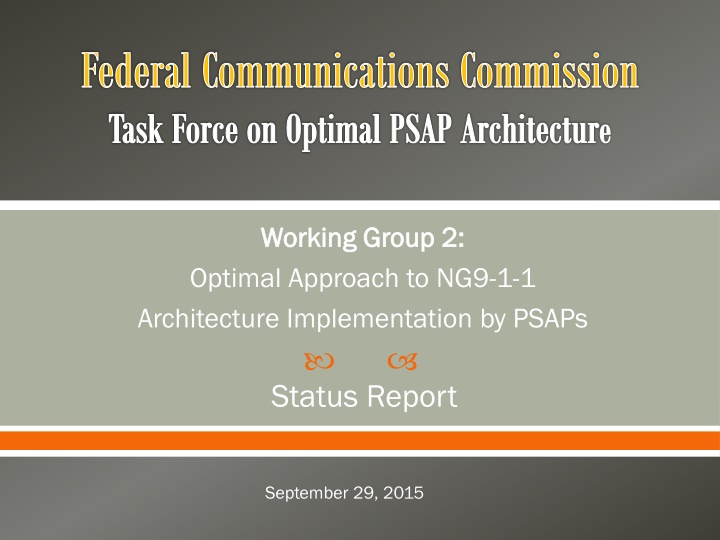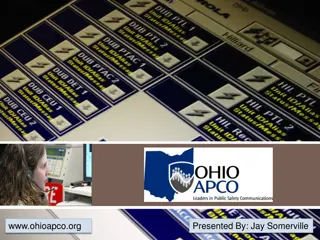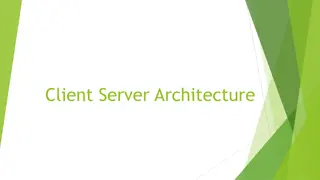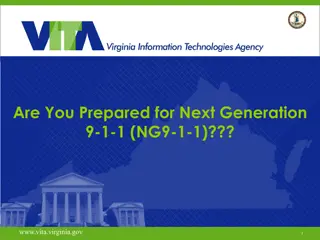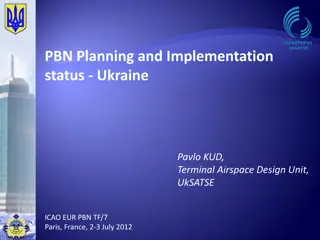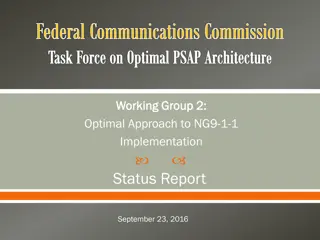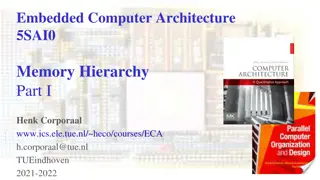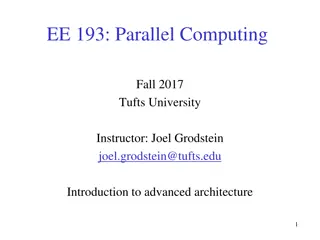Optimal Approach to NG9-1-1 Architecture Implementation by PSAPs
Federal Communications Commission Task Force on Optimal PSAP Architecture Working Group 2 explores the evolution of 9-1-1 systems from legacy circuit-switched routing to IP-based architectures. It delves into the challenges faced in designing the optimal NG9-1-1 architecture, emphasizing the shift towards data-driven telematics and SIP connectivity. The working group aims to provide decision-makers with key factors to consider for successful implementation and configuration of Next Generation 9-1-1 systems.
Uploaded on Oct 07, 2024 | 0 Views
Download Presentation

Please find below an Image/Link to download the presentation.
The content on the website is provided AS IS for your information and personal use only. It may not be sold, licensed, or shared on other websites without obtaining consent from the author.If you encounter any issues during the download, it is possible that the publisher has removed the file from their server.
You are allowed to download the files provided on this website for personal or commercial use, subject to the condition that they are used lawfully. All files are the property of their respective owners.
The content on the website is provided AS IS for your information and personal use only. It may not be sold, licensed, or shared on other websites without obtaining consent from the author.
E N D
Presentation Transcript
Federal Communications Commission Task Force on Optimal PSAP Architecture Working Group 2: Working Group 2: Optimal Approach to NG9-1-1 Architecture Implementation by PSAPs Status Report September 29, 2015
9-1-1 Legacy Framework: Circuit Switched Selective Routing For over forty years circuit switched selective routing through Telephone Company central offices became the norm for routing 9-1-1 calls. Customer devices rarely moved without administrative control, and the strategy of telephone numbers directly correlating to a physical dispatchable address was a valid assumption. Although cell phone technology existed as early as 1973, it was not until mid-nineteen eighties that the next major step occurred in mobile phone technology with the First Generation (1G) fully automatic cellular networks introduction. TFOPA WG2 Optimal NG9-1-1 Service Architecture 2
Moving Rapidly Into the IP Evolution From the 1980 s through today, wireless technologies continued to develop through the 2G, 3G and now 4G LTE evolutions. As we move forward with new IP based services, Graphic Information (GIS) location, and data-driven telematics, the contact with 9-1-1 telecommunications will not solely be driven by voice calls and callers . SIP, a session initiation protocol supporting real-time media will provide connectivity to 9-1-1 centers, through a variety of session access technologies. We must embrace this new philosophical change in our thinking, and relegate calls and callers to the history books. TFOPA WG2 Optimal NG9-1-1 Service Architecture 3
Questions Challenging WG2 o What is the optimal architecture for NG9-1-1? o Is there one best and optimal design ? o If so, what are the elements required for that design? o If not, what are the various configurations that could be combined together to reach that optimal objective? These and many, many other questions have been confronting 9-1-1 decision-makers, as they attempt to correlate and make sense out of competing information and, often, have limited best practice guidance to assist them in knowing how to arrive at a successful conclusion. TFOPA WG2 Optimal NG9-1-1 Service Architecture 4
WG2 Optimal Architecture The FCC tasked this working group with just that in mind; to answer the question, What is the optimal architecture for Next Generation 9-1-1? Goal of WG2 - Through this work decision-makers, tasked with the challenges of making choices for design and configuration of their 9-1-1 systems, will be capable of understanding not only the key decision factors, but also the broader understanding of the relevant impact of those decisions. TFOPA WG2 Optimal NG9-1-1 Service Architecture 5
WG2 Divided Into Three Subgroups Access and NG9 Access and NG9- -1 1- -1 Core Services Terminating Equipment, 9 Terminating Equipment, 9- -1 1- -1 Call and Dispatching and Dispatching PSAP CPE ESInet Implementation ESInet Implementation 1 Core Services 1. 1. 1 Call- -taking, Mapping, CAD, taking, Mapping, CAD, PSAP CPE 2. 2. 3. 3. Each group is tasked with research, analysis, and discussions pertaining to their subject area(s) and developing drafts of the anticipated final report sections and recommendations. WG2 holds weekly conference calls to discuss subgroup work. TFOPA WG2 Optimal NG9-1-1 Service Architecture 6
What is Optimal Architecture? It is the belief of Working Group 2 that there is no one best design and one best choice, but rather a number of options from which to chose for "optimal architecture" of NG9-1-1 systems, depending on local, regional, and state environments. Accordingly, WG2 s intent is to create the road map that details the components and potential configuration choices available to decision-makers. TFOPA WG2 Optimal NG9-1-1 Service Architecture 7
Configuration Options State Multi-State Hosted Regional By NGCS State Network hosted * County GIS Substate Local Local (Substate) OSPs Physical or virtual PSAP NG9-1-1 Core Services (NGCS) Terminating Eqpt 9-1-1 Calltaking Access A WAN / LAN State Substate County? ESInet IP transport network To below * Could be at County or Regional level Hosted Regional Hosted Local Local GIS Local Mapping, CAD, MIS, etc Eqpt Field Dispatching Radio A Responders FirstNet? WAN / LAN ESInet IP transport network RCH 062315 TFOPA WG2 Optimal NG9-1-1 Service Architecture 8
Major Sections of the Report 1. Executive Summary 2. Introduction Introduction 3. Current PSAP Decentralized Environment Current PSAP Decentralized Environment 4. PSAP Optimization Options PSAP Optimization Options 5. ESInet Optimization ESInet Optimization 6. Call Access and NG9 Call Access and NG9- -1 1- -1 Core Services Optimization Optimization 7. Optimization Decision Matrix Optimization Decision Matrix 8. Assumptions 9. Recommendations 10. Definitions 1 Core Services TFOPA WG2 Optimal NG9-1-1 Service Architecture 9
PSAP CPE & Dispatch Subgroup Status Section 3: Section 3: Current Decentralized PSAP Environment Current Decentralized PSAP Environment o Objective: Objective: To describe elements within the legacy decentralized PSAP environments and identify governance structures and operational impacts that should be considered as a part of NG9-1-1 and PSAP Optimization. o Status: Status: Adopted by Work Group for incorporation into Final WG2 Report. TFOPA WG2 Optimal NG9-1-1 Service Architecture 10
PSAP CPE & Dispatch Subgroup Status Section 4.1: PSAP Optimization Options Section 4.1: PSAP Optimization Options o Goal of Section: Goal of Section: To develop PSAP Optimization Models including Considerations, Factors, Advantage and Challenges. Assumes deployment of NG9-1-1 Core Services & ESInet Infrastructure to flexibly configure call flow and applications. TFOPA WG2 Optimal NG9-1-1 Service Architecture 11
PSAP CPE & Dispatch Subgroup Status PSAP Operational Models Include: o Shared Services (Centralized Location) o Hybrid (Multiple Locations common equipment) o Centralized Call Taking (Centralized Neutral Call Taking Facility) o Consolidation By Discipline (Primary / Secondary PSAP) o Virtual (Hosted Network Solutions: Call Handling, ACD, CAD) Maintains PSAP autonomy for operational decision making and meeting the needs of local public safety agencies. o Status: Status: Draft completed by sub-team and under review by full Work Group. TFOPA WG2 NG9-1-1 Optinal PSAP Architecture 12
PSAP CPE & Dispatch Subgroup Status Section 4.2: PSAP Infrastructure Deployment Optimization Section 4.2: PSAP Infrastructure Deployment Optimization Models Models o Goal of Section: Goal of Section: To provide architectural models for sharing of NG9-1-1 infrastructure while allowing for the diversity of PSAP Operational models identified in 4.1 Infrastructure Models o Status: Status: Draft currently under sub-team review and scheduled for completion by end of September. TFOPA WG2 Optimal NG9-1-1 Service Architecture 13
ESInet Subgroup Status Section 5: Section 5: o Goal of section Goal of section Provide design considerations for Emergency Services IP Network (ESInet) architecture as an element of the overall optimal NG9-1-1 service architecture strategy. o Status: Status: Draft currently under sub-team review and scheduled for completion by mid-October. ESInet as defined by NENA: o the network, not the services that ride on the the network, not the services that ride on the network network TFOPA WG2 Optimal NG9-1-1 Service Architecture 14
ESInet Subgroup Status ESInet sub-team focus areas: o Architecture Transport Internet Protocol (IP) Services Management Infrastructure Security Infrastructure o Defined Uses & Configurations Local Regionally Hosted Hosted/Managed o Network Monitoring & Operational Metrics Device Level Visibility Performance Metrics o Legal/Regulatory o Governance & Administrative Considerations TFOPA WG2 Optimal NG9-1-1 Service Architecture 15
Access and Core Services Subgroup Status Section 6: Section 6: o Goal of Section: Goal of Section: To describe the legacy Access and E9-1-1 service system environments, identify governance structures and operational models, and optimization options and factors that should be considered as part of NG911 service system optimization. o Considerations Considerations: Emergency call and message access to various levels of NG9-1-1 core services optimization Originating Service Provider (OSP) provided data provision options Validation and access choices Multiple choices for optimization of NG9-1-1 Core Services implementation Describe optimization models for the above, with pros and cons TFOPA WG2 Optimal NG9-1-1 Service Architecture 16
Access and Core Services Subgroup Status o Status: Status: Draft of explanatory text partially complete Have not yet integrated the optimization factors evaluation and text This group will lead on terms and terminology clarification work for review by WG2 Full draft of subgroup's section(s) to be ready for review by third week of October TFOPA WG2 NG9-1-1 Optinal PSAP Architecture 17
Optimization Decision Matrix Section 7: Section 7: o Goal of Section Goal of Section: Based upon the work outlined in Sections 3 through 6, this Section will present: a roadmap of various options available to a PSAP governance authority the possible configurations that they may wish to develop to achieve an optimal NG9-1-1 solution for their circumstances o Status: Status: Pending completion of previous Sections TFOPA WG2 Optimal NG9-1-1 Service Architecture 18
WG2 Summary Much work has been done by all Working Group members during weekly conference calls. More is yet to be accomplished. Generally, WG2 members are working to identify the: o Optimal Factors o Core Components o Designs of Optimal Architecture o Configuration Variations o Scenario Options Available o Roadmap Guidance and Challenge to Decision-makers TFOPA WG2 Optimal NG9-1-1 Service Architecture 19
Questions or Comments TFOPA WG2 Optimal NG9-1-1 Service Architecture 20
